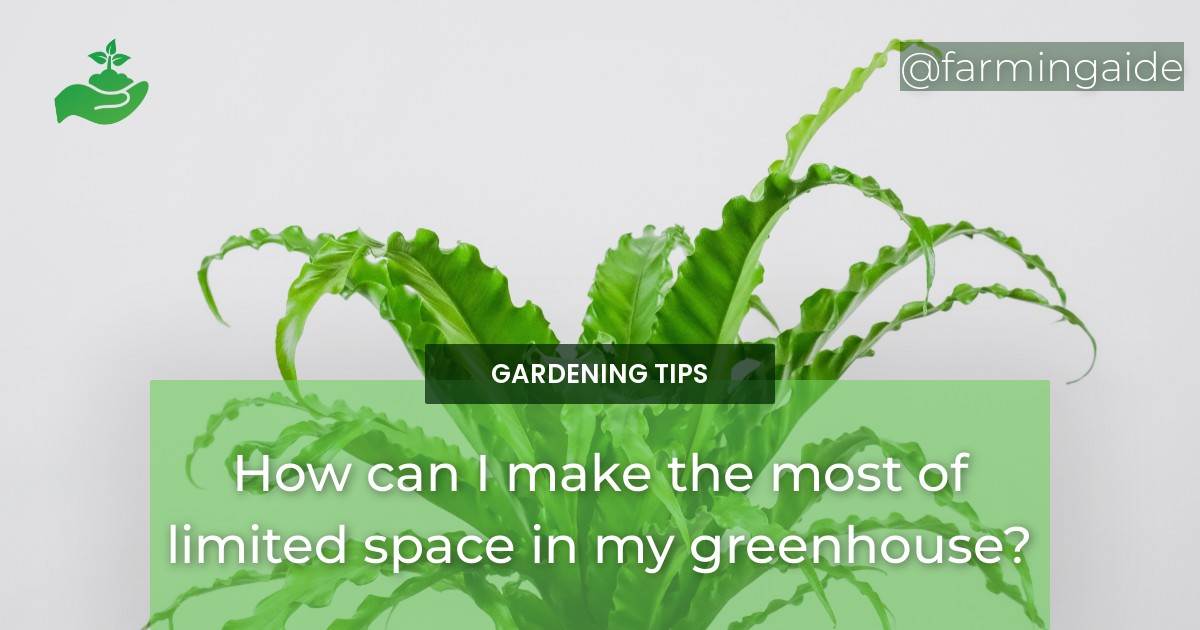When it comes to gardening in a greenhouse, limited space can be a challenge. However, with the right techniques and strategies, you can make the most of your space and still grow a bountiful garden. In this article, we will explore some effective ways to maximize limited space in your greenhouse and achieve optimal results.
Utilizing Vertical Space
One of the best ways to make the most of limited space in your greenhouse is to use vertical space. By growing plants vertically, you can maximize your growing area while still providing your plants with the space they need to grow and thrive.
Trellises for Vining Plants
Trellises are a great option for vining plants like cucumbers, beans, and peas. By training these plants to grow up trellises, you can save space and prevent them from sprawling out on the ground. This not only makes more room for other plants but also helps to keep your greenhouse organized and tidy.
Hanging Baskets for Small Fruits and Vegetables
Hanging baskets are another effective way to utilize vertical space. They are perfect for growing small fruits and vegetables like strawberries, cherry tomatoes, and herbs. By hanging these plants from the ceiling of your greenhouse, you can free up valuable floor space and add visual interest to your garden.
Using Shelves or Tiered Growing Systems
Another effective way to maximize limited space in your greenhouse is to use shelves or tiered growing systems. These systems allow you to stack plants vertically while still providing them with the light and water they need to grow.
Shelving for Seedlings and Small Pots
Shelving is perfect for seedlings and small pots. By using shelves, you can stack these plants vertically and create more space for other plants. This is especially useful if you are starting your plants from seeds and need to make the most of your limited space.
Tiered Growing Systems for Plants That Don’t Require Deep Soil
Tiered growing systems are ideal for plants that don’t require deep soil. These systems allow you to stack plants vertically without the need for a lot of soil. They are perfect for growing plants like lettuces, herbs, and strawberries.
ALSO READ
Growing Compact or Dwarf Varieties of Plants
Another effective way to maximize limited space in your greenhouse is to grow compact or dwarf varieties of plants. These plants are specifically bred to grow in small spaces and require less room than their full-sized counterparts.
Dwarf Fruit Trees and Berry Bushes
Dwarf fruit trees and berry bushes are perfect for small spaces. They can be grown in pots or planted directly in the ground. By choosing dwarf varieties, you can enjoy the same delicious fruit without taking up a lot of space in your greenhouse.
Compact Varieties of Tomatoes, Peppers, and Other Vegetables
Compact varieties of vegetables like tomatoes and peppers are also great for small spaces. These plants are bred to produce a lot of fruit in a small area, making them perfect for greenhouse gardening. They are also easy to grow and require less maintenance than their full-sized counterparts.
Miniature Herbs for Small Spaces
Miniature herbs are perfect for small spaces. They can be grown in pots or on shelves and require less room than traditional herbs. They are also easy to care for and can be used in a variety of recipes.
Implementing Space-Saving Techniques for Pathways and Organization
Finally, implementing space-saving techniques for pathways and organization can help you make the most of limited space in your greenhouse. By using compact tools, vertical tool storage, and efficient pathways, you can keep your greenhouse organized and easy to navigate.
Compact Tools for Tight Spaces
Compact tools like pruners, shears, and trowels are perfect for tight spaces. They take up less room than traditional tools and are still effective at getting the job done. Plus, they are often easier to handle and more lightweight than their full-sized counterparts.
Vertical Tool Storage
Vertical tool storage is another effective way to save space in your greenhouse. By hanging your tools vertically, you can free up valuable floor space and keep your tools organized and easy to access. This is especially useful if you have a lot of tools and limited space to work with.
Efficient Pathways for Easy Access
Finally, efficient pathways are essential for easy access to your plants. By designing your pathways to be as efficient as possible, you can save space and make it easier to care for your plants. This can also help to prevent damage to your plants and make them easier to harvest when the time comes.
ALSO READ
How Can I Use Temperature and Humidity Control to Maximize Limited Space in My Greenhouse?
When maximizing limited space in your greenhouse, utilizing tips for greenhouse climate control is essential. By carefully monitoring and adjusting temperature and humidity levels, you can optimize the growing conditions for your plants. Utilize tools like fans, heaters, and misting systems to create the ideal environment for your crops.
Conclusion
Maximizing limited space in your greenhouse is all about utilizing vertical space, using shelves or tiered growing systems, growing compact or dwarf varieties of plants, and implementing space-saving techniques for pathways and organization. By following these tips and strategies, you can make the most of your space and still grow a bountiful garden.


